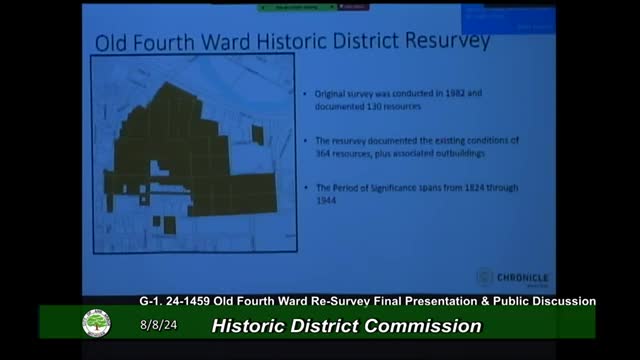Historic district survey reveals architectural treasures and challenges
August 09, 2024 | Ann Arbor City, Washtenaw County, Michigan

This article was created by AI summarizing key points discussed. AI makes mistakes, so for full details and context, please refer to the video of the full meeting. Please report any errors so we can fix them. Report an error »

In a recent government meeting, officials discussed the findings of a comprehensive resurvey of the Old Fourth Ward historic district, which had not been assessed since 1982. The new survey, conducted in late October and early November 2023, documented 364 resources, revealing significant changes in the district's historical landscape.
The survey categorized each resource as either contributing or non-contributing based on its historic integrity and construction date, which spans from 1824 to 1944. Of the surveyed resources, 324 were deemed contributing, while 41 were classified as non-contributing. Notably, only eight of the non-contributing resources were built during the period of significance, primarily due to substantial loss of historic integrity. These include several properties on East Ann Street and North Division Street.
The meeting highlighted the architectural diversity within the district, which encompasses 322 residential properties, 20 apartment buildings, eight commercial resources, four schools, eight churches, and two government buildings. The district's development patterns reflect various architectural styles, including Classical Revival, Gothic Revival, Victorian, and Art Deco, showcasing a rich tapestry of historical influences.
The Old Fourth Ward is now recommended for listing in the National Register of Historic Places under Criterion C for its architectural significance. The period of significance, spanning 120 years, is noted as unusual, embodying distinctive characteristics of multiple architectural types.
In addition to the survey findings, the meeting included recommendations for future preservation efforts. These include implementing legally binding covenants for property transfers, enhancing collaboration between the Historic District Commission and university planners, and promoting the history of Black residency in the district through educational initiatives.
The discussions underscored the importance of preserving the Old Fourth Ward's historical integrity while addressing contemporary development needs. The meeting concluded with a call for ongoing advocacy and engagement with current residents to ensure the district's rich heritage is maintained for future generations.
The survey categorized each resource as either contributing or non-contributing based on its historic integrity and construction date, which spans from 1824 to 1944. Of the surveyed resources, 324 were deemed contributing, while 41 were classified as non-contributing. Notably, only eight of the non-contributing resources were built during the period of significance, primarily due to substantial loss of historic integrity. These include several properties on East Ann Street and North Division Street.
The meeting highlighted the architectural diversity within the district, which encompasses 322 residential properties, 20 apartment buildings, eight commercial resources, four schools, eight churches, and two government buildings. The district's development patterns reflect various architectural styles, including Classical Revival, Gothic Revival, Victorian, and Art Deco, showcasing a rich tapestry of historical influences.
The Old Fourth Ward is now recommended for listing in the National Register of Historic Places under Criterion C for its architectural significance. The period of significance, spanning 120 years, is noted as unusual, embodying distinctive characteristics of multiple architectural types.
In addition to the survey findings, the meeting included recommendations for future preservation efforts. These include implementing legally binding covenants for property transfers, enhancing collaboration between the Historic District Commission and university planners, and promoting the history of Black residency in the district through educational initiatives.
The discussions underscored the importance of preserving the Old Fourth Ward's historical integrity while addressing contemporary development needs. The meeting concluded with a call for ongoing advocacy and engagement with current residents to ensure the district's rich heritage is maintained for future generations.
View full meeting
This article is based on a recent meeting—watch the full video and explore the complete transcript for deeper insights into the discussion.
View full meeting
